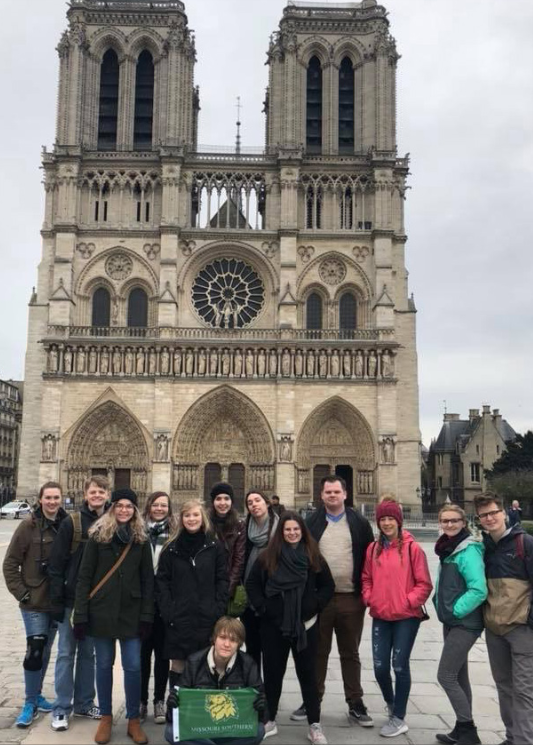City’s Heart Aflame
Students from the 2018 global journalism course in front of the Notre Dame cathedral in Paris. France.
As a fire broke out in the 856-year-old Notre Dame cathedral on Monday, April 15, people in France and all over the world watched as smoke billowed out from the gothic structure.
A building – which took 200 years to build, endured wars and revolutions – was at the mercy of a fast-growing fire.
Notre Dame was home to sacred Christian relics, including the crown of thorns, which is believed to be what Jesus Christ wore while he was crucified.
People watched as a nation’s history flake away and morph into burnt crisps. The fire began during Holy Week, a time when Christians honor the last week of Jesus’ life from Palm Sunday to Easter.
In Joplin, those within the Missouri Southern community and others, who have been to the sacred site, understand what was at stake on Monday.
“As an art historian I was heartbroken.” said Dr. Christine Bentley, art history professor. “The very thing the medieval architects were fighting against was fire or the structure collapsing.”
At St. Peter’s the Apostle Catholic Church, Father Chaz Dunn couldn’t believe what he read in the news. He admits he thought it was a prank.
“It was such heartache to see that this happened, but warmed my heart to see the resolve of the French people,” said Dunn.
A group of communications students visited the cathedral during the 2018 spring break trip through a global journalism.
“I felt a little shaken up inside, because it holds a special place in my heart,” said Karsten Gilbert, Missouri Southern graduate and communications coordinator for the University of Tulsa. “I was worried the whole thing would come down.
“My footprints have been in there.”
The fire tore through two thirds of the roof, effectively disintegrating wood that has held up for more than 800 years.
“The roof is often referenced as a forest,” said Bentley. “The roof itself involved 52 acres of trees cut down in the 12th century. Each beam was one tree.”
Dunn calls the Notre Dame cathedral a “Catholic icon.”
“This is a place where people have worshipped for centuries,” said Dunn. “The architecture raises our eyes up to God.”
The students who studied abroad in Paris had similar experiences.
While not all of them identify as Catholic, Gilbert and Kristen Fidler, senior communication major, both experienced the effect the cathedral has been known to have.
“You could really understand the psychology of religion, where they made things really large to dwarf you in the presence of God,” said Fidler.
Seeing Notre Dame wasn’t merely a pit stop for the students. They went on an excursion through the ancient cathedral’s bell tower in undesirable conditions.
Gilbert said it was an estimated 30 degrees with heavy rain and snow.
It helped, she said, there was a dessert place that sold crepes right next door to keep them occupied while waiting to enter.
“They know how to bake over there,” said Gilbert, who tried the strawberry and Nutella crepe.
Once inside, students smushed and squeezed their way through a long set of spiral staircases, that almost made some people want to go back down.
“There was a little entrance where you could shuffle through and get to this tiny bell tower” said Fidler. “You wouldn’t think it would be that small.”
Gilbert said once they made it to the top, everything was worth the view.
While the bell tower was smaller than expected, being inside the cathedral was the exact opposite.
“In terms of architectural technology, what they accomplished with the height of the structure is amazing,” said Bentley.
Visitors flock in the thousands each day to experience this ancient structure.
“It’s not just a Paris treasure, but a world treasure,” said Gilbert.
Soon after the cathedral caught fire, French President Emmanuel Macron announced it would be rebuilt.
“Notre Dame is our history, it’s our literature, it’s our imagery,” said Macron in a televised statement. “It’s the place where we live our greatest moments, from wars to pandemics to liberations.
“I’m telling you all tonight — we will rebuild this cathedral together. This is probably part of the French destiny.”
Fidler believes in France’s ability to fix the damages.
“When we went there, it was modern building next to historical buildings,” said Fidler. “Old and new resided side by side. If anyone could rebuild something that old, it would be France.”
This is not the first time that the Notre Dame needed to be fixed.
The spire that collapsed Monday, was not the original. Bentley said it was rebuilt in the 19th century after being neglected.
“I believe it is human nature to forget about the impermanence of our world,” said Fidler. “Our societies and architecture do not last forever. Everything has its time, and everything dies.
“I think we would rather not acknowledge that fact. That is why the burning of Notre Dame is so hard for us to accept.”
Your donation will support the student journalists of Missouri Southern State University. Your contribution will allow us to purchase equipment and cover our annual website hosting costs.




























